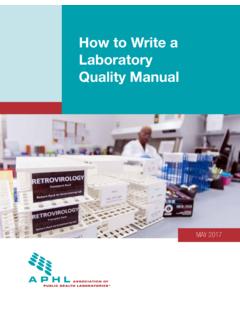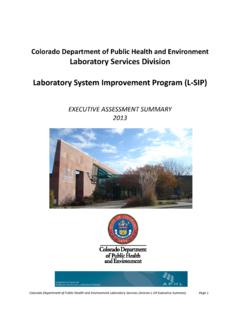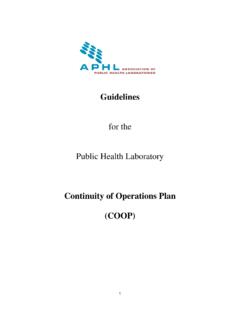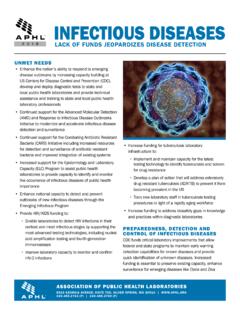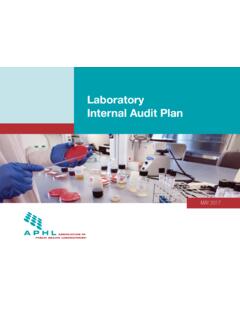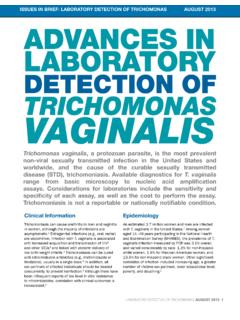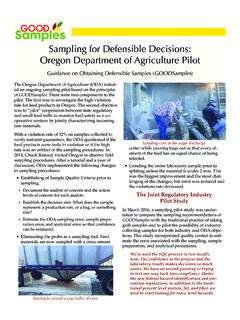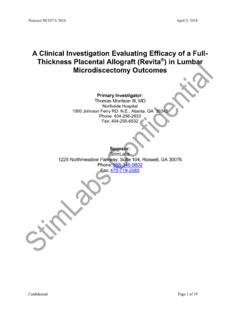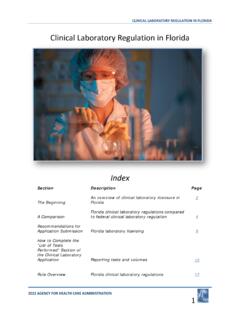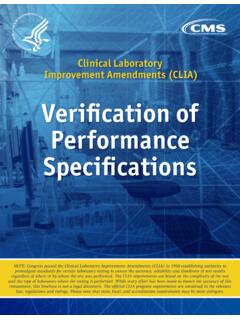Transcription of Molecular Laboratory Design, QA/QC Considerations
1 Rachel Lee, Department of State Health ServicesNBS Molecular Training WorkshopMarch 7, 2017 Molecular Laboratory Design, QA/QC ConsiderationsLaboratory Regulatory and Accreditation Guidelines US Food and Drug Administration (FDA): Approves kits and reagents for use in clinical testing Proposed oversight for Laboratory Developed Test clinical Laboratory improvement Amendments (CLIA): Regulations passed by Congress 1988 to establish quality standards for all Laboratory testing to ensure the accuracy, reliability and timeliness of patient test results regardless of where the test was performed College of American Pathologists (CAP): Molecular Pathology checklist International Organization for Standardization standards ISO 17025:2005 General requirements for the competence of testing and calibration laboratories ISO 15189.
2 2012 Medical laboratories --Requirements for quality and competence State Specific Regulations NY clinical Laboratory Evaluation Program (CLEP)Professional Guidelines American College of Medical Genetics (ACMG) Professional Guidelines clinical and Laboratory Standards Institute (CLSI)Professional Guidelines clinical and Laboratory Standards Institute (CLSI)Professional Guidelines Association of Molecular PathologistsMolecular Laboratory DesignContamination Introduction of unwanted nucleic acids into specimen the sensitivity of PCR techniques makes them vulnerable to contamination Repeated amplification of the same target sequence leads to accumulation of amplification products in the Laboratory environment A typical PCR generates as many as 109copies of target sequence Aerosols from pipettes will contain as many as 106amplification products Buildup of aerosolized amplification products will contaminate Laboratory reagents, equipment.
3 And ventilation systems IINucleic acid amplification procedures ( PCR) are designed to minimize carryover (false positive results) using appropriate physical containment and procedural : This item is primarily directed at ensuring adequate physical separation of pre-and post-amplification samples to avoid amplicon contamination. The extreme sensitivity of amplification systems requires that the Laboratory take special precautions. For example, pre- and post-amplification samples should be manipulated in physically separate areas; glovesmust be worn and frequently changed during processing; dedicated pipettes (positive displacement type or with aerosol barrier tips) must be used; and manipulations must minimize aerosolization.
4 In a given run, specimens should be ordered in the following sequence: patient samples, positive controls, negative controls(including no template controls in which target DNA is omitted and therefore no product is expected). Enzymatic destruction of amplification products is often helpful, as is real-time measurement of products to avoid manual manipulation of amplification of Compliance: Written procedure that defines the use of physical containment and procedural controls as applicable to minimize carryoverCAP Molecular Pathology ChecklistPotential Sources of Contamination Cross contamination between specimens Amplification product contamination Laboratory surfaces Ventilation ducts Reagents/supplies Hair, skin, saliva.
5 And clothes of lab personnelWhat Happens If Lack Of Contamination Control Incorrect results Require extensive cleanup Loss of creditability Financial and performance impactHow to Control Contamination Laboratory design Laboratory practices Chemical and enzymatic controlsSetting Up a Molecular Laboratory Mechanical barriers to prevent contamination Spatial separation of pre- and post-amplification work areas Area 1 Reagent preparation Area 2 Specimen/control preparation, PCR set-up Area 3 Amplification/product detection, plasmid preparation Physically separated and, preferably, at a substantial distance from each otherUnidirectional Flow Both personnel, including cleaning personnel, and specimens Amplification product-free to product-rich Remove PPE before leaving one area Avoid or limit reverse direction Reusable supplies in the reverse direction need to be MM19-A Establishing Molecular Testing in clinical Laboratory EnvironmentsFeatures of the 3 Areas Each area has separate sets of equipment and supplies Refrigerator/freezer (manual defrost) Pipettes, filtered tips, tubes, and racks Centrifuge, timers, vortex Lab coat (color-coded)
6 , disposable gloves, safety glasses, and other PPE Cleaning supplies Office supplies Ventilation system Dead air box with UV light serves as a clean bench areaFeatures of the 3 Areas Air pressure Reagent Prep Positive Sample Prep - Negative Postamplification- Negative Reagent Prep Single entrance, reagents used for amplification should not be exposed to other areas Specimen Prep Specimens should not be exposed to post-amplification work areas Size of each area should consider space for equipment and bench space needed for preparationLaboratory Design Areas Only Area 1 Reagent prep, specimen prep.
7 And target loading use of laminar-flow hoods Area 2 Amplification/product detectionAlternative to Spatial Separation Class II biological safety cabinet Dedicated areas for each work phase Unidirectional Automated specimen processing station/closed-tube amplification and detection systemCore Laboratory Concept On site combine with microbiological testing Off site academic instituteOther Laboratory Design Considerations Temperature and humidity requirements Exhaust ventilation Water quality Electric outlet Back-up power system Eye wash Ergonomic assessment Need for storage area Need for waste disposal areaLaboratory Practices Use of positive displacement pipettes and disposable filtered pipette tips Avoid production of aerosols when pipetting Use of sterilized single-use plasticware Use of cleanroom sticky floor mats Minimizes the risk of ampliconcarry-over on clothing, hair and skin Hairnet Dedicated safety glasses Disposable labcoat/gown, color-coded preferred Gloves.
8 Need to change periodically Shoe coversMore Laboratory Practices Clean punches between samples Use of nuclease free or autoclaved water Aliquot oligonucleotides multiple freeze thaws will cause degradation Always include a blank (no template) control to check for contamination Use of electronic data system (flow of paper) Wipe test (swab test) Monthly Detect, localize, and remove contamination Identify the source of the contaminationDecontamination Approaches Clean the work area & equipment routinely Clean the PCR workstation at the start and end of each work day/run (UV light, 70% ethanol, fresh 10% sodium hypochlorite, DNA Away) Clean the exterior and interior parts of the pipette Clean the equipment Clean the doorknobs, handle of freezersChemical and Enzymatic Controls Work stations should all be cleaned with 10% sodium hypochlorite solution (bleach), followed by removal of the bleach with ethanol and water.
9 Ultra-violet light irradiation UV light induces thymidine dimers and other modifications that render nucleic acid inactive as a template for amplification Enzymatic inactivation with uracil-N-glycosylase Substitution of uracil (dUTP) for thymine (dTTP) during PCR amplification New PCR sample reactions pre-treated with Uracil-N-glycosylase(UNG) contaminating PCR ampliconsare degraded leaving only genomic DNA available for PCRQ uality ControlsMonitor all steps of analytical procedure Types of Control Frequency and Number of Controls Evaluation of Controls and CalibratorsTypes of Controls Internal Control Internal positive amplification controls to detect failure of DNA extraction or PCR amplification Reagent or equipment issues Integrity of DNA sample Presence of inhibitory substance External Control Positive control Negative control (normal, wild type) No template control (extraction blank)
10 BlankInternal ControlsReference gene ( RNaseP)External Controls Positive and negative controls: Inhibitors Component failure Interpretation of results Sources: Residual DBS PT samples QC materials No template controls and Blanks: Nucleic acid contamination during extraction Nucleic acid contamination during PCRF requency and Number of External Controls Based on risk Ideally should represent each target allele and include in each run, but may not be feasible when: Highly multiplex genotypesoSystematic rotation of different alleles as positivesoSpecimens representing short and long amplification products to control for differential amplification Rare alleles Quantitative PCR External controls should represent more than one concentration, low and high positives and negative, covering the analytical measurement range Daily run or with each runs After equipment maintenance, new operator.

